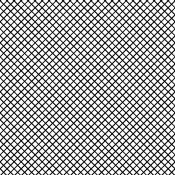Using the checkerboard screen is similar to the old way of doing halftone before soft dot screens were made available. These are used with a space between the film and the screen to allow the edges of the checkerboard pattern shadow to soften. The details of the spacing is dependent on the light source and the film used among other things. Its not easy to get technically great results but doable. The grid used to be on glass and suspended over the film to control the spacing but I would imagine a clear piece of film or two could do the same thing in a vacuum frame. The next obstacle would be to have high enough contrast paper to create hard edged dots from a halftone screen. This used to be available to the graphic arts industry along with special developers to get lithographic contrast but is much harder to source now.
After that would be experimenting to get the proper baseline exposure for the shadow dot and the required bump exposure to bring up the highlight dot on your positive print. Been there done that, years working a process camera at a local newspaper before the digital revolution.
All good, but getting a high contrast developer will require mixing from scratch chemicals today. In the distant past I had a go at mixing my own lithofilm developer, it was successful, but it took too much time from a business point of view. I was using it every day, so time cost money and I continued to purchase litho film developer; usually Agfa as theirs was the cheapest.
The only sort of odd ingredients were Diethylene Glycol and Formaldehyde (37%), everything else would be on the shelf of a person mixing their developers from scratch.
One needs to ensure you have fresh stop bath and back then you needed a hardening fixer. I almost always used 24ºC, as that was what our deep roller transport baths used at work.
Question as I was not a camera operator, was your highlight dot aim around 10% to 15%?
With regard to adding some clear sheets of film, that did work for me in the past, sometimes though, going through the back door was enough to soften things (contact printing where the dot screen is not emulsion to emulsion). Somewhere I still have some halftone sheets of film taken directly from original glass sheet line screens. I have 40#, 55#, 60#, 65# and 90# inch half tone. For home use without a good vacuum frame, I couldn't hold highlight dots any finer than 90#, even then I was being ambitious. 55# which is 55 lines per inch, worked the best; as far as I can remember.
Mick.













